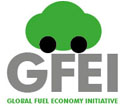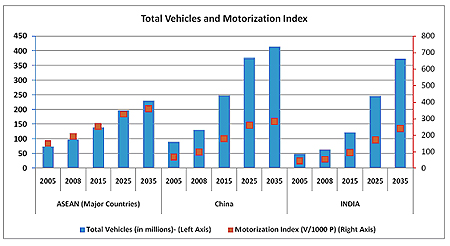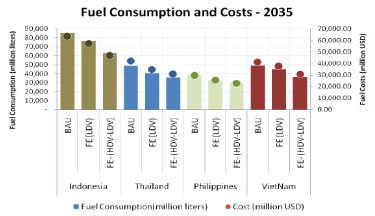
Philippines Developing Automotive Fuel Economy Policy
1.1 Background
Motorization rates (in terms of vehicle ownership per 1000 people) in ASEAN (Association of Southeast Asian Nations) countries are high, in most cases higher than India and China. However, the personal vehicle of choice remains the 2-3 wheeler, followed by cars. Overall, the region could benefit from mandatory fuel economy policies and measures to improve fuel security and lower costs, climate change and air pollution. In ASEAN countries, such policies and measures could lead to up to 16% reductions in fuel and CO2 emissions if applied to light duty vehicles (LDVs) and up to 26% if applied to both LDVs and high duty vehicles (HDVs). Thailand is furthest advanced with concrete proposals for such standards for LDVs and will be adding other vehicle types step by step (CAI-Asia 2010).In the Philippines (an ASEAN country), the transport sector takes up about 65% of the country’s oil consumption. As motorization increases, demand for fuel will rise.
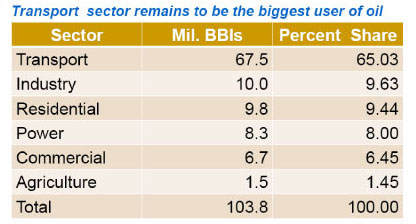
Credit : Tamang 2011.
1.2 1.2 Philippines Light-Duty Vehicle Fleet
The Philippines do not have an auto fuel economy standard in place, but the country’s energy efficiency plans and efforts acknowledge the importance of transport in energy consumption and foresee the development and implementation of fuel economy labelling for new cars, in addition to expanding the use of alternative fuels and vehicles, and improved mass transit systems (Tamang 2011). Because HDV’s are a significant part of the of the overall vehicle kilometres travelled in ASEAN countries, including the Philippines, and therefore have a large impact on CO2 and conventional emissions, future fuel economy policies should cover both light duty and heavy duty vehicles.
Total diesel and gasoline fuel consumption and costs in 2035 under a business-as-usual scenario
Note: BAU = Business-as-usual; FE (LDV) = Fuel economy improvement for light-duty vehicles only; FE (HDV) = Fuel economy improvement for light-duty and heavy-duty vehicles. Credit: CAI-Asia 2010
1.3 Status of LDV fleet fuel consumption/CO2 emissions
Currently the Philippines do not have a road transport fuel economy policy in place. However, analysis by the Global Fuel Economy Initiative and CAI-Asia (see references below) shows that reductions in CO2 emissions from the sector are possible through standards, with sizeable reductions over business as usual scenarios.
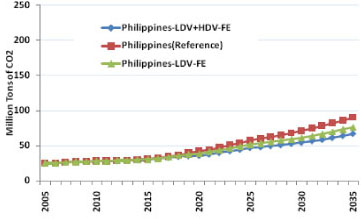
Impact of Fuel Economy Standards in the Philippines on CO2 emissions
Note: Reference = Business-as-usual; LDV- FE = Fuel economy improvement for light-duty vehicles only; LDV+HDV-FE = Fuel economy improvement for light-duty and heavy-duty vehicles. Credit: CAI-Asia 2010
The country has already made strides in putting in place policies to limit conventional vehicle emissions, and similar efforts could be made to limit greenhouse has emissions from road vehicles, including heavy duty trucks and buses. Beginning in January 2008, all new motor vehicles introduced into the market must comply with Euro 2 emission limits and since 2003, all new vehicles must also pass an emission test before registration (CAI-Asia 2010).
2.0 Regulatory Policies
2.1 National Standard
Currently the Philippines do not have a road transport fuel economy policy in place. However, the country has a comprehensive National Energy and Efficiency and Conservation Program (NEECP) which aims to contribute towards the achievement of 60% energy self-sufficiency by 2010 and the avoidance of 50.9 million tons of CO2 emissions for the period 2005 to 2014. But the program does not include the development and implementation of fuel economy standards (CAI-Asia 2010).
In 2006 a Government Energy Management Program (GEMP) was initiated which set specific directives in improving the efficiency and conservation of fuel use in government vehicles by 10% from the average monthly consumption in the first semester 2004, for all government entities. To complement this program, any vehicle purchased by the government should have displacements of no more than 1600cc for petrol and 2500cc for diesel engines.
2.2 Test cycle type
The national Department of Energy has undertaken some fuel economy measures, including promoting eco driving and conducting “fuel economy runs” which includes testing of vehicle fuel consumption fuel use by running a pre-selected route and distance. Results are widely publicized and the event is an opportunity for consumers to learn about new technology. However, no formal testing cycle has been adopted.
2.3 Import restrictions
New Vehicles
In 2004, Executive Order No. 397 was signed to promote the low engine displacement and hybrid vehicles by reducing the rates of import duty on completely-knocked-down parts and components for such vehicles. Executive Order No. 396 was also signed in 2004 which reduced the import duties on natural gas motor vehicles to 0% in an effort to promote CNG vehicles in the country. The House Bill 2637 or the Alternative Fuel Vehicles Act 2004 promotes the manufacture, importation, sale, distribution and use of hybrid and alternative fuel vehicles through tax exemptions and provision of incentives was authored. However, the document is still pending with the Committee on Trade and Industry (CAI-Asia 2010).
Second Hand
Importation of used vehicles is dependent upon compliance with emissions requirements as set out under the Clean Air Act, which governs conventional pollutants.
2.4 Technology mandates/targets
An initiative to promote alternative fuel vehicles, the government is implementing an ‘Alternative Fuels Program’ which taps into the country’s domestic produce as a useful source of energy. The Alternative Fuels Program has 4 sub-programs: Biodiesel Program, Bioethanol Program, Natural Gas Vehicle Program for Public Transport, and Autogas Program. Other alternative fuel technologies, such as hydrogen, fuel cell, hybrids and electric vehicles are also promoted. Part of this program is also the use of four-stroke engines for motorcycles and tricycles, and use of electric-powered motorcycles or electric bikes (CAI-Asia 2010).
3.0 Fiscal Measures and Economic Instruments
3.1 Fuel Taxes
Fuel prices are not significantly subsidized by the Pilipino government, due to the ‘Downstream Oil Industry Deregulation Act of 1998’, which liberalized and deregulated the downstream oil industry. However, in 2008 the government provided funding for fuel discounts for tricycle drivers which continued up until 2009, and was aimed at alleviating the impacts of the continuous rise in fuel prices on the livelihoods of drivers (CAI-Asia 2010
3.2 Fee-bate
N/A
3.3 Buy-back
N/A
3.4 Other tax instruments
Tariffs on vehicles are based on engine displacement (for passenger vehicles) and gross weight (for goods vehicles), whereas the automobile excise tax structure is based on the displacement of the engine, with a larger displacement paying more taxes (CAI-Asia 2010). Import duties on low engine displacement and hybrid vehicles were reduced in 2004, at the same time a reduction in the import duties on natural gas vehicles was brought to 0% in an effort to promote CNG vehicles in the country.
3.5 Registration fees
Although unclear if registration fees exist, there is a motor vehicle inspection system for vehicles prior to registration.
3.6 R&D
N/A
4.0 Traffic Control Measures
4.1 Priority lanes
N/A
4.2 Parking
N/A
4.3 Road pricing
N/A
5.0 Information
5.1 Labeling
N/A
5.2 Public info
The government has initiated the ‘Road Transport Patrol’ which aims for a 10% reduction in fuel consumption through activities that provide consumers with information on the efficient use of fuel through proper vehicle maintenance, efficient driving, and values formation among drivers through seminars/workshops.
5.3 Industry reporting
Vehicle manufacturers who wish to sell in the Philippines must provide various ratings for those vehicles. The Standard Bureau checks these ratings against their own tests, and if found inaccurate, the vehicle company loses the right to sell that vehicle. Once the Energy Conservation Legislation bill passes, fuel economy standards could be included in the tests carried out by the Standards Bureau.
The text above is a summary and synthesis of the following sources:
- Clean Air Initiative for Asian Cities (CAI-Asia). “Improving Vehicle Fuel Economy in the ASEAN.” July 2010.
- Phon-Amnuaisauk, Sommai. International Institute for Energy Conservation. “ASEAN Energy Efficiency and Energy Conservation Policies”, Presentation at the Third Meeting of the Southeast Asia Network of Climate Change Focal Points. 30th June 2010.
- Tamang, Jesus T. Philippines Department of Energy. “Philippines: National Priorities for Energy Efficiency and Conservation.” Presentation at the Fourth Meeting of the Southeast Asia Network of Climate Change Focal Points. May 4-5 2011.
